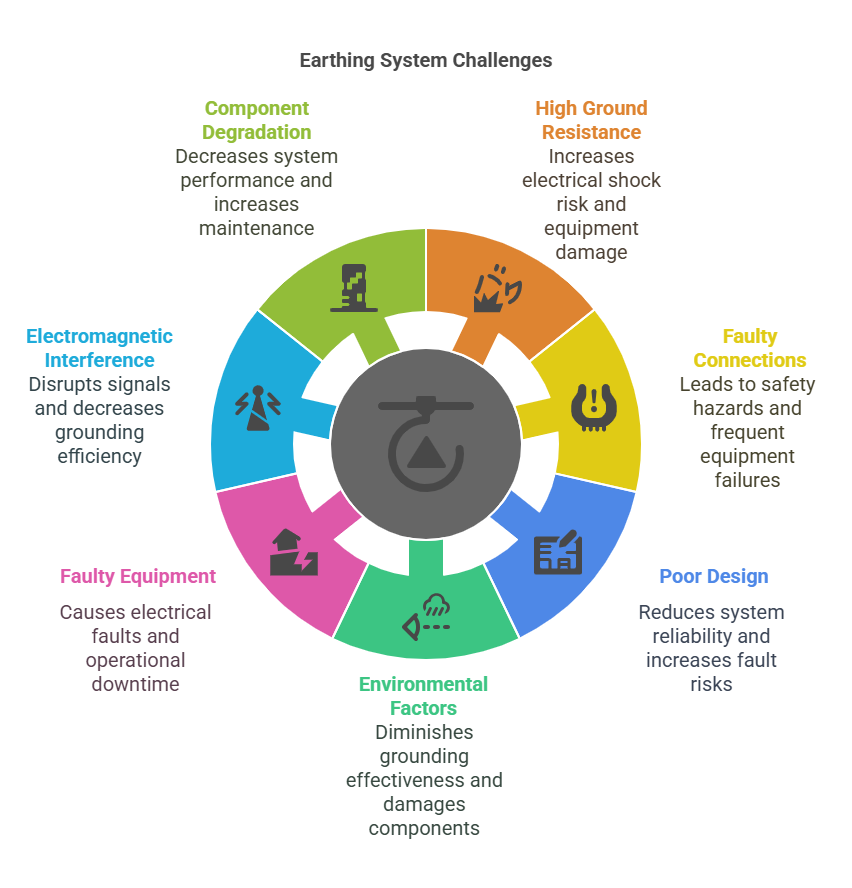Introduction
Effective earthing or grounding systems are essential for electrical safety, designed to safely channel fault currents into the ground and prevent hazards. However, various factors can impede this crucial process, leading to significant issues for both safety and equipment reliability. This blog delves into the key causes of current dissipation failures and their impacts, providing a clear understanding of how these issues arise and their potential consequences.

1. High Ground Resistance
Cause: Ground resistance is a critical factor in the effectiveness of an earthing system. High ground resistance occurs when the soil or material around the grounding electrodes has poor electrical conductivity. This can result from dry soil conditions, rocky terrain, or the presence of corrosive substances that affect the grounding electrodes. For example, in arid regions where the soil lacks moisture, the ground resistance can be significantly higher, leading to inefficient current dissipation and reduced earthing benefits.
Impact:
- Increased Risk of Electrical Shock: High ground resistance impedes the safe dissipation of fault currents, elevating the risk of electrical shock to personnel.
- Equipment Damage: Inefficient earthing or grounding due to high resistance can lead to overheating and damage to electrical equipment.
- Operational Disruptions: Poor grounding performance from high resistance can cause frequent equipment failures and operational inefficiencies.
2. Faulty Connections
Cause: Faulty connections in an earthing system often result from loose or corroded connections, improper installation, or wear and tear over time. These issues can stem from inadequate maintenance practices or environmental factors that accelerate deterioration. For example, connections exposed to moisture or chemicals can corrode, leading to ineffective earthing or grounding.
Impact:
- Increased Safety Hazards: Loose or corroded connections disrupt the flow of fault currents, increasing the risk of electrical hazards.
- Frequent Equipment Failures: Inconsistent grounding due to faulty connections can lead to regular breakdowns and malfunctions of electrical equipment.
- Higher Maintenance Costs: Persistent issues from faulty connections require ongoing maintenance and repairs, driving up operational costs.
3. Poorly Designed Earthing System
Cause: A poorly designed earthing system may involve undersized conductors, improperly placed electrodes, or design flaws resulting from insufficient planning. Factors such as incorrect component selection or failure to consider environmental conditions during design can compromise the system’s effectiveness. For instance, using conductors that are too small for the expected fault currents can lead to overheating and inadequate earthing or grounding.
Impact:
- Reduced System Reliability: Poor design results in an ineffective grounding system that cannot handle fault currents properly, reducing overall system reliability.
- Operational Inefficiencies: Design flaws lead to frequent operational issues and equipment failures.
- Increased Risk of Electrical Faults: An inadequate design heightens the risk of electrical faults and safety hazards.
4. Environmental Factors
Cause: Environmental conditions significantly impact the performance of an earthing system. Heavy rainfall, flooding, extreme temperatures, and exposure to chemicals can alter the soil’s conductivity and damage grounding components. For example, prolonged exposure to water can lead to the corrosion of grounding electrodes, while extreme temperatures can affect the material properties of conductors, ultimately diminishing the earthing benefits.
Impact:
- Diminished Grounding Effectiveness: Changes in environmental conditions can impair the grounding system’s ability to effectively dissipate fault currents.
- Component Damage: Harsh environmental conditions can physically damage grounding components, leading to reduced performance.
- Increased Safety Risks: Ineffective grounding due to environmental factors raises safety risks for both personnel and equipment.
5. Faulty Equipment
Cause: Equipment with improper or defective grounding connections disrupts the earthing or grounding process. Faults in equipment such as transformers, generators, or electrical panels can cause incomplete grounding, often due to design flaws, manufacturing defects, or installation errors.
Impact:
- Increased Risk of Electrical Faults: Faulty equipment fails to ground effectively, leading to potential electrical faults and safety hazards.
- Equipment Damage: Sensitive equipment may suffer from damage due to improper grounding.
- Operational Downtime: Faulty equipment results in costly operational disruptions and reduced system reliability.
6. Electromagnetic Interference (EMI)
Cause: Electromagnetic interference from high-power electrical devices or radio frequencies can disrupt the performance of an earthing system. EMI can induce unwanted voltages in grounding systems, affecting fault current flow and grounding effectiveness.
Impact:
- Signal Disturbances: EMI can interfere with electronic equipment and communication systems, affecting their performance.
- Decreased Grounding Efficiency: Interference disrupts the effective dissipation of fault currents, leading to operational issues.
- Increased Equipment Vulnerability: Sensitive equipment becomes more susceptible to damage from electrical disturbances caused by EMI.
7. Component Degradation
Cause: Over time, grounding system components such as electrodes and conductors can degrade due to physical wear, corrosion, and environmental exposure. This degradation can occur from natural ageing, chemical reactions, or mechanical stress.
Impact:
- Decreased System Performance: Degradation of components reduces the effectiveness of current dissipation and overall system performance.
- Increased Maintenance Needs: Worn-out components require frequent maintenance and replacements, adding to operational costs.
- Higher Safety Risks: Degraded components compromise earthing or grounding effectiveness, increasing safety risks.
Marconite Earthing System – promises 25+ years of maintenance-free, water-free, chemical-free earthing
Marconite Earthing System stands out as a premium choice for effective earthing or grounding due to its innovative composition and advanced design. Unlike traditional earthing materials, Marconite combines high conductivity with exceptional durability, making it uniquely suited to address common grounding challenges. Its advanced properties make it an ideal choice for overcoming the common issues that can impair current dissipation:
– Low Ground Resistance:
Marconite’s high conductivity ensures low ground resistance, even in challenging conditions. This results in efficient grounding and enhanced earthing benefits, allowing effective fault current dissipation and improving electrical safety.
– Durability and Corrosion Resistance:
Marconite excels in harsh environments with its strong resistance to corrosion and environmental wear. This ensures long-term performance and reliability, reducing the need for frequent maintenance and highlighting its earthing benefits.
– Robust Design:
Engineered to withstand high fault currents and environmental stresses, Marconite minimizes maintenance needs while maximizing safety. Its robust design ensures that the benefits of grounding or earthing are maintained under demanding conditions.
– Effective EMI Shielding:
Marconite’s ability to resist electromagnetic interference (EMI) protects sensitive equipment and maintains grounding efficiency, ensuring reliable performance and safeguarding against electrical disturbances.
Conclusion
Understanding the factors that impede current dissipation in earthing systems is crucial for ensuring safety and reliability. High ground resistance, faulty connections, and environmental conditions can all compromise performance.
The Marconite Earthing System is the best solution to these issues, offering low ground resistance, exceptional durability, and resistance to corrosion. By choosing the Marconite Earthing System, you enhance the benefits of grounding earthing and ensure long-term reliability, providing a better earthing or grounding solution that safeguards your electrical infrastructure.






